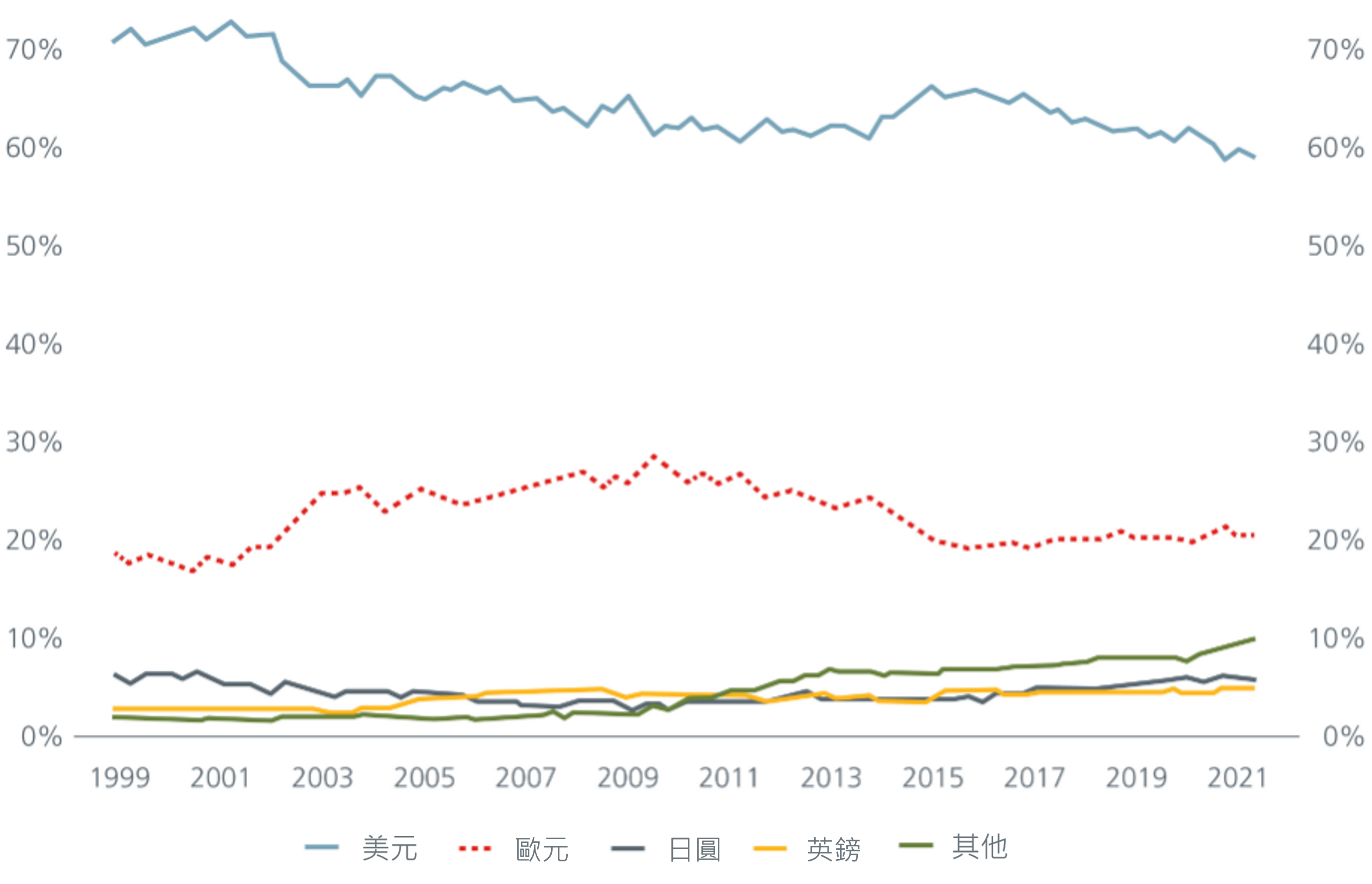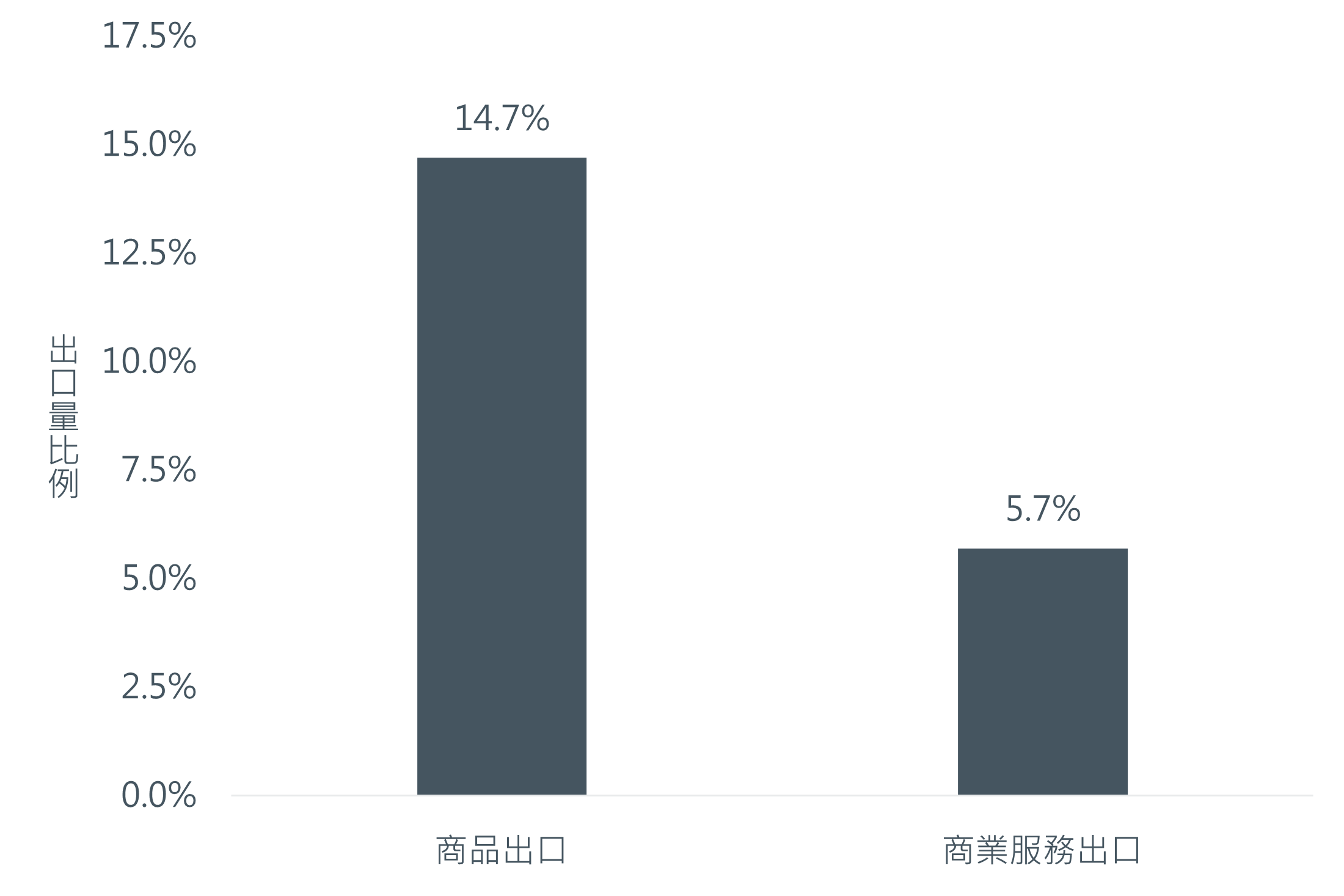美元是二戰和建立布列敦森林制度後,全球最重要的國際儲備貨幣。雖然以購買力平價(PPP)來計算,美國的經濟僅占全球國內生產毛額不到20%,不過卻有將近90%的全球貨幣交易是使用美元,且全球40%的債券是以美元發行。根據統計資料,截至2021年底,美元佔全球央行外匯存底60%。(見圖1)
圖1:1999年至2021年全球外匯存底的貨幣組成(百分比)

資料來源:國際貨幣基金組織官方外匯存底貨幣組成(COFER)。
註:「其他」類別包括澳幣、加拿大幣、人民幣、瑞士法郎及在COFER調查中並未單獨列出的其他貨幣。中國在2015年至2018年間成為COFER的報告國家。
市場時常質疑美國的儲備貨幣主導地位。長久以來,許多評論批評美國獨攬過多的特權,藉由誘人的利率為大量個人及企業貸款籌措資金,保持其對全球金融體系的關鍵影響力。然而到目前為止,儘管不認同美元為儲備貨幣主導國的聲音愈來愈多,但依舊沒有出現其他貨幣能取代美元的主導地位。
成為儲備貨幣的必備條件
經濟與安全這兩大因素是各國選擇儲備貨幣的主要考量。因此,貨幣作為交易、價值儲存及記帳單位的媒介,安全性、流動性、規模經濟、貿易關係及金融產業合作是左右各國政府及大量使用跨境支付的企業決定使用哪種貨幣的關鍵。
藉由這個觀點,我們可以知道當資本市場自由,經濟體就會具備借貸市場的影響力、並賦予總體經濟穩定。所以當一個經濟體的特色符合龐大、穩定和高流動性,就可以完美地與上文做為儲備貨幣的條件吻合。
除了金錢上的考量外,經濟學家巴里·艾肯格林的學術研究也顯示,國際儲備貨幣的組成很大程度取決於地緣政治、戰略、外交和軍事因素。各國認為使用盟國或經濟政治實力強的國家的貨幣進行國際貿易,能符合地緣政治利益。
過去四十年,美元在流動性及安全性方面已經無可取代,美國實力雄厚的經濟及市場主導地位,支撐了美元的價值。就避險考量而言,投資人及企業儲備現金管理人會偏好以美元計價的資產,因為美元計價的資產除了避險的功能外,即使美國經濟受到衝擊,美元還是相對穩定。
美國是全球最大的資本市場,佔全球股市的41%及全球固定收益市場的40%,為企業儲備現金管理人帶來外匯存底運動的流動性優勢。
1990年代開始全球貿易進入快速成長期,國內生產毛額(GDP)中,出口的比例由15%上升至現今的25%。得益於大部分商品以美元交易,成就了現在美元的地位。
舉例來說,與美國友好的德國、日本及沙烏地阿拉伯,其大部分外匯存底都是以美元為主。
美元的安全性將受到質疑
俄羅斯入侵烏克蘭後,美國及其盟國宣佈欲凍結俄羅斯中央銀行的外匯存底。至今,俄羅斯擁有的價值6,430億美元外匯存底中,約有一半被凍結,僅剩人民幣及黃金儲備可自由運用。
不過,基於美國常常憑藉著對美元的主導權,利用美元作為解決經濟問題的工具,導致部分企業儲備現金管理人需要重新評估其儲備資產的「安全性」。對於不是美國的盟國或者不支持美國及其同盟國家政治意識形態的國家而言,是否繼續以美元作為儲備資產成為了一項迫切需要被解決的問題。例如,2019年中國被視為鎮壓香港反送中大遊行的主導者,時任美國總統川普威脅對中國實施經濟制裁,包括拒絕中國金融機構進入美元融資市場,這凸顯了當前非美同盟國政府的兩難。
去全球化及區域經貿貿易組織的崛起
如果説全球化定義了1990年代及2000年初期的全球經濟,那麼隨著2017年中美貿易戰爆發,2010年代代表着全球化趨勢自高峰回落。然而,儘管全球貿易額在2010年代達到高峰,但中國佔全球出口量的比例仍持續成長,目前達15%,這樣的規模讓中國的金融及經濟影響力不容小覷。(見圖2)
圖2:2020年中國佔全球出口量的比例

資料來源:statista 2022。
徵收關稅及推動製造業在地化促使區域經貿組織以中國為中心發展。
跨太平洋夥伴全面進步協定(CPTPP)於2018年生效,是亞洲、歐洲及美洲國家(排除美國)之間的區域貿易協定。2020年,中國與14個亞洲國家簽署區域全面經濟夥伴協定(RCEP),成員大部分來自東協。同年,東協取代歐盟成為中國最大的貿易夥伴。
非洲國家方面,非洲聯盟提出了非洲大陸自由貿易協定(AfCFTA),目的是促進非洲的貿易關係,連結非洲的55個經濟體,並且已經獲得其中38個國家的加入批准。對中國而言,由於中國在過去十年裡一直是非洲最大的投資國,AfCFTA的簽訂整合了擁有13億人口、總收入達3.4兆美元的非洲,中國能夠因此獲利。
總結來說,美元在全球經濟的主導地位,可能隨著愈來愈多以中國為中心的經貿組織出現,日漸受到威脅。
可能取代美元成為新興世界儲備貨幣:人民幣
對於傾向不支持美國意識形態的企業儲備現金管理人來說,人民幣在分散風險的特性上,或許是不錯的替代儲備貨幣。而且自2000年代起,中國一直向境外機構投資人逐步開放國內的資本市場。
中國的人民幣跨境支付系統(CIPS)於2015年推出,為跨境的人民幣付款及貿易參與者提供結算及交收服務,以提高人民幣在全球市場的流通。在當前美國及歐洲對俄羅斯實施制裁的局勢,部分投資人開始考慮以CIPS取代環球銀行金融電信協會(SWIFT)。
2016年,人民幣被納入國際貨幣基金組織(IMF)特別提款權(SDR)一籃子貨幣,提高了人民幣作為儲備貨幣的地位,讓人民幣與美元、歐元、日元、英鎊平起平坐人民幣國際化的步伐持續加快,最近推出的數位人民幣旨在提高人民幣的國際流通量及使用量。
中國亦於2018年將以人民幣計價的原油期貨引進上海國際能源交易中心。自此,市場的交易量每年增加超過20%,達到了創紀錄的水準。此外,市場對於各國將對俄羅斯展開石油出口實施制裁的擔憂,也可能加快市場轉向至中國交易所使用人民幣,制裁甚至會擴展至大型商品交易所的對沖與石油交易。
人民幣目前僅佔全球貨幣儲備的3%,但由於中國的經濟規模及影響力,人民幣的實際占比會超3%。以平價購買力來說,中國的GDP在2014年已超越美國,在經濟發展速度上也超過了美國與歐洲。
人民幣計價資產及亞洲固定收益的地位提昇
過去四十年間,美元一直處在領導地位,但在日益多角化的世界中,其全球儲備的占比似乎大不如前。在最近一份文件中,國際貨幣基金組織指出自本世紀初以來,美元佔全球貨幣儲備的比例持續下降,其中四分之一的金流轉為人民幣,其餘則轉為較小型國家之貨幣,例如澳幣、加幣、韓元及新加坡幣。非傳統儲備貨幣 受益於不斷成長的流動性以及更積極的準備金管理,使它具有更高的風險溢酬。
相關研究指出隨著全球外匯存底逐步多元化以及中國經濟影響力日益增加,在2030年,人民幣佔全球外匯存底可能上升至10% 。著名國際經濟學家羅格夫亦表示,如果人民幣流動性增加及容易兌換,未來人民幣佔全球儲備的比例可能會與美元的比例相當。
隨著中國對其貿易夥伴有一定的經濟及政治主導權,未來儲備管理重心勢必會轉移到中國,進而延伸至整個亞洲,因此亞洲佔全球經濟產量的比例必然逐步升高。雖然此轉變不會馬上發生,但已然開始,並會隨著地緣政治緊張局勢升溫而加速。我們相信就人民幣計價債券以及其他亞洲當地貨幣債券需求而言,長期來說必定有所成長。